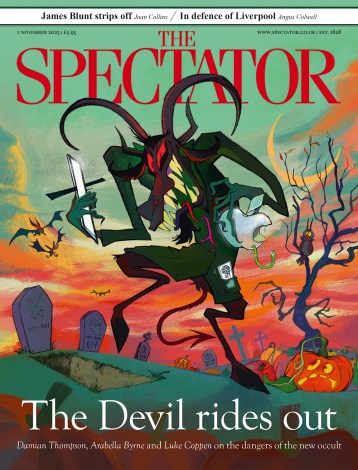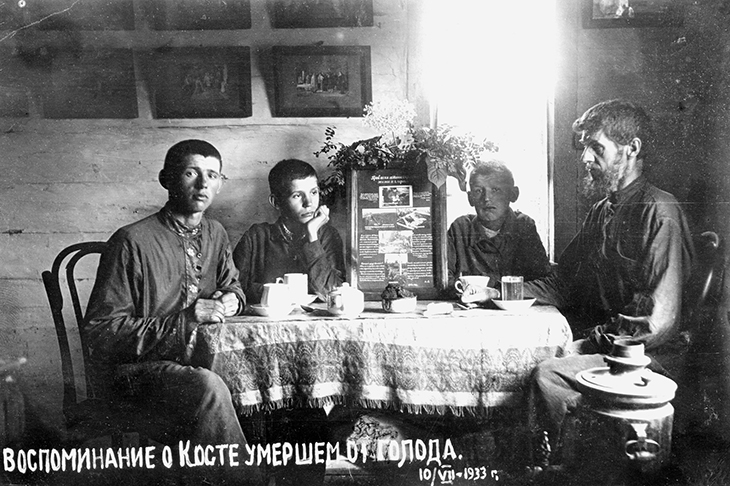In 1933 my aunt Lenina Bibikova was eight years old. She lived in Kharkov, Ukraine. Every morning a polished black Packard automobile would draw up to the door of the handsome pre-revolutionary mansion her family shared with other senior Party cadres to take her father to his job as Party boss at the Kharkov Tractor Factory. When he returned in the evening her father would be carrying bulging packets of sausages and meat from the factory canteen. Lenina did not remember wanting for anything.
Yet in reality Kharkov, like all Ukraine’s cities in that terrible year, was an island of plenty in a sea of starvation. All over Ukraine millions of peasants were dying of hunger in a massive, man-made famine deliberately unleashed by the Soviet state. As Anne Applebaum chronicles in her wrenching, vivid and brilliant account of the Holodomor — literally, the ‘hunger-death’ — famine had become the main weapon of a war unleashed by Stalin on both the reactionary peasant class and on Ukrainian national identity itself.
During the famine years those peasants who managed to crawl to Ukraine’s cities, bellies bloated from hunger, were rounded up by special trucks that patrolled at night on secret orders from the municipal authorities to pick up the living and the dead. By morning there was no trace, for those who chose not to see, of the horror which was unfolding all around.
That wilful blindness has continued ever since. For Ukrainian nationalists, the Holodomor was a genocide unleashed against their people that is today commemorated in a day of national mourning akin to Holocaust memorial day in Israel. For the Soviet authorities — and now, disgustingly, Putin’s tame historians — the great famines of the early 1930s were nothing more than a natural disaster.
As Applebaum shows, drawing on a wealth of witness accounts and Soviet archival sources, there was little natural about it. From the earliest days of the Revolution, she writes, ‘the link between food and power was something that the Bolsheviks also understood very well… constant shortages made food supplies a hugely significant political tool. Whoever had bread had followers, soldiers, loyal friends.’ As early as 1921 Maksim Litvinov — later Soviet foreign minister — told a group of visiting American aid workers coming to help the starving of the Volga, in his precise but accented English, ‘Yes, but food is a veppon…’
It took Stalin’s ruthless genius to fully weaponise hunger as a tool of total war against the enemies — real or imagined — of the Soviet regime. The first Five Year Plan of 1928 called for peasants’ private land to be confiscated and all herds and grain to be turned over to the new collective farms. All over the Soviet Union, peasants slaughtered their livestock and gorged themselves rather than give them up to the Soviet state. Eyewitnesses from the Red Cross reported seeing peasants ‘drunk on food’, their eyes stupefied by their mad, self-destructive gluttony, and the knowledge of its consequences. Harvests from the new collective farms fell disastrously. By the summer of 1932, it was clear that Ukraine — for centuries the grain-basket of the Russian empire thanks to its fertile black earth and twice-yearly harvests of winter barley and summer wheat — had catastrophically failed to meet the production quotas set by the Kremlin. Stalin reverted to what he knew best from his days as a bank-robber in Tbilisi — violence, and theft. Requisition gangs were sent to seize grain reserves, seed reserves, animal fodder and, ominously, daily food supplies.
The unfulfilled portion of the Plan had to be ‘fulfilled unconditionally, completely, not lowering it by an ounce’, Stalin’s lieutenant Vyacheslav Molotov told the Ukrainian authorities in October 1932. Already, the secret police had rounded up wealthy peasants who had resisted collectivisation and shipped them to newly built gulags in their tens of thousands — the guards dubbed the trainloads of humanity ‘white coal’. Now, the Soviet authorities unleashed something very close to a war on their own Ukrainian citizens. ‘During the Revolution I saw things that I would not want even my enemies to see,’ wrote the Politburo member Nikolai Bukharin. ‘Yet in 1919 we were fighting for our lives… but in 1930–33 we were conducting a mass annihilation of completely defenceless men together with their wives and children.’
On 1 January 1933 Stalin demanded that the Party use a recent law on ‘theft of state property’ to prosecute collective and individual farmers in Ukraine who were allegedly hiding grain. That telegram is probably the closest thing we have to a direct command from the Kremlin ordering the Holodomor. Stalin’s cable, writes Applebaum, ‘was a signal to begin mass searches and persecutions… in practice that telegram forced Ukrainian peasants to make a fatal choice. They could give up their grain reserves and die of starvation, or they could keep some grain reserves hidden and risk arrest, execution or the confiscation of the rest of their food — after which they would also die of starvation.’
The result was ‘such inhuman, unimaginable misery, such a terrible disaster, that it began to seem almost abstract, it would not fit within the bounds of consciousness’, wrote Boris Pasternak after a trip to Ukraine. The young Hungarian communist Arthur Koestler found the ‘enormous land wrapped in silence’. The British socialist Malcolm Muggeridge took a train to Kiev, where he found the rural population starving. Embittered, the idealistic Muggeridge left the Soviet Union, convinced he had witnessed ‘one of the most monstrous crimes in history, so terrible that people in the future will scarcely be able to believe it ever happened’.
The enduring tragedy of the Holodomor — which left at least five million dead, including almost four million Ukrainians — is that Muggeridge was right. Plenty of modern Russians still don’t believe it ever happened. Since Ukraine’s independence — and even more so since the Russian annexation of Crimea in 2014 and the ensuing Russian-backed separatist war in Donbass — the Holodomor has become an ideological touchstone, as vehemently denied by the Kremlin as it is promoted by nationalist Ukrainians.
Applebaum resists the passions of that raging ideological battle and sticks to the relentless, horrifying facts, unequivocally documented in the Soviet secret police reports, eyewitness accounts and the correspondence of senior Party leaders. She squarely places the Holodomor in the wider context of the Soviet regime’s battle with Ukrainian identity itself (an imperial crusade against separatism inherited from the Tsars). ‘Famine was only half the story,’ she writes. ‘While peasants were dying in the countryside, the Soviet secret police simultaneously launched an attack on the Ukrainian intellectual and political elites. As the famine spread, a campaign of slander and repression was launched against Ukrainian intellectuals, professors, museum curators, writers, artists, priests, theologians, public officials and bureaucrats.’ The archives show that Stalin’s aim was demonstrably not just to exterminate the reactionary peasantry but to squash all memory of the independent Ukrainian state that had flickered briefly in the aftermath of the first world war.
Perhaps most controversial is the debate over whether the Holodomor was, in fact, a genocide. Some commentators have accused Applebaum of shying away from that loaded word — though in fact she is perfectly clear that the debate is a purely semantic one. Raphael Lemkin, the Polish-Jewish lawyer who invented the word ‘genocide’, spoke of the Holodomor as the ‘classic example’ of his concept: ‘It is a case of genocide, of destruction, not of individuals only, but of a culture and a nation.’ The controversy stems, as Applebaum explains in a carefully written epilogue, from the later, more legalistic definition of ‘genocide’ as set down by the United Nations in 1948. The Soviet delegation to the first UN General Assembly had argued that political persecution was ‘entirely out of place in a scientific definition of genocide’, and successfully lobbied that the official definition be restricted to the annihilation of entire ethnic groups. ‘Genocide’ thereafter became ‘organically bound up with fascism-nazism and other similar race theories’, Applebaum writes. ‘The Holodomor does not meet that criterion. The Ukrainian famine was not an attempt to eliminate every single living Ukrainian; it was also halted, in the summer of 1933, well before it could devastate the entire nation.’
Applebaum’s summary of the reality of the genocide debate says more about Moscow’s successful — and cynical — manipulation of international discourse than it does about the events of 1930–34 in Ukraine. But it will also anger Ukrainian nationalists who see the Holodomor — as they see today’s conflict in Donbass — as a species of epic blood feud between the two Slavic nations. They are wrong. Both conflicts are about the Kremlin’s imperial programme of power and control rather than blind ethnic hatred.
Today’s ideologically charged conflict between Kiev and Moscow often reduces history to the cannon fodder of propaganda. That makes Applebaum’s meticulous study — the first since Robert Conquest’s excellent but inevitably poorly sourced The Harvest of Sorrow (1986) — so important. The Soviet state successfully concealed the reality of the Holodomor even from children like Lenina Bibikova who were growing up in its midst — then spent 70 years denying its crimes. Applebaum has drawn back the veil — with the same force, clarity and readability as in her earlier books on the Gulag and on the Soviet postwar conquest of Eastern Europe — on one of the 20th century’s most egregious crimes.







Comments